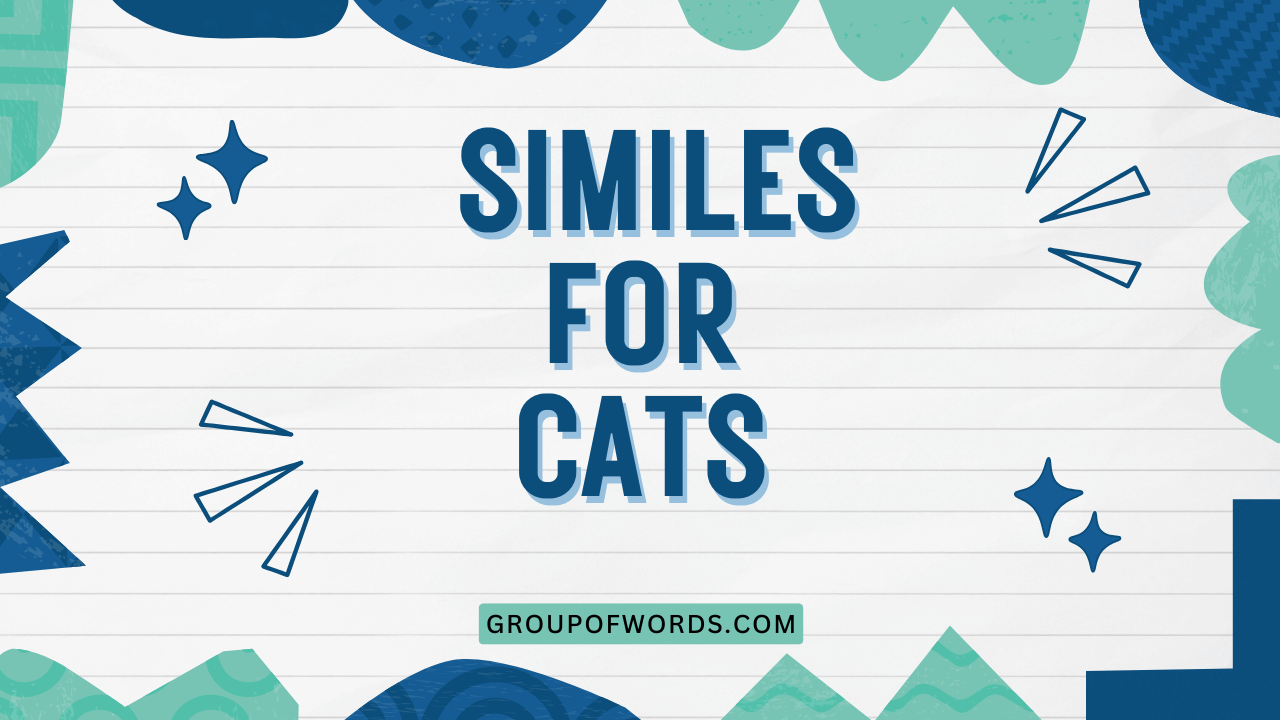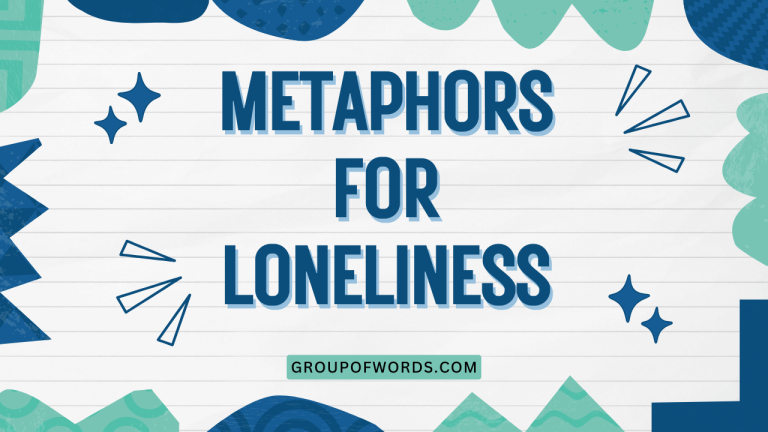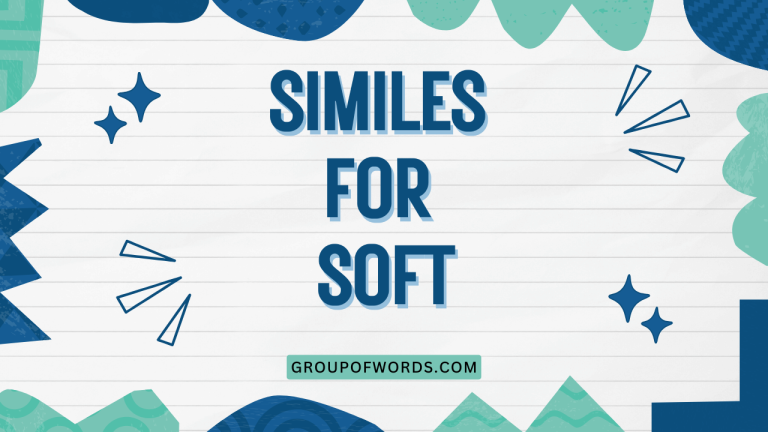Purrfect Comparisons: Mastering Similes for Cats
Similes are powerful tools in the English language, allowing us to create vivid descriptions and comparisons. Understanding how to use similes effectively can significantly enhance your writing and communication skills.
This article focuses specifically on similes used to describe cats, exploring their structure, function, and various examples. Whether you’re a student learning grammar basics or a writer seeking to add flair to your prose, this guide will provide you with the knowledge and practice you need to master similes for cats.
This article is designed for English language learners, writers, and anyone interested in improving their descriptive writing skills. By the end of this guide, you’ll be able to identify, understand, and create compelling similes that capture the unique qualities of cats.
Table of Contents
- Introduction
- Definition of Simile
- Structural Breakdown of Similes
- Types of Cat Similes
- Examples of Similes for Cats
- Usage Rules for Similes
- Common Mistakes with Similes
- Practice Exercises
- Advanced Topics in Similes
- Frequently Asked Questions
- Conclusion
Definition of Simile
A simile is a figure of speech that compares two unlike things using the words “like” or “as.” It’s a way to create a vivid image in the reader’s mind by drawing a connection between something familiar and something less familiar. Similes are essential for descriptive writing, allowing authors to add depth, color, and emotional resonance to their work.
They help make abstract concepts more concrete and relatable.
In essence, a simile states that one thing is similar to another, highlighting specific qualities or characteristics they share. This comparison is not meant to be taken literally; rather, it’s used to evoke a certain feeling or understanding. Similes are widely used in literature, poetry, and everyday conversation to enhance communication and make language more engaging. For example, saying “The cat’s fur was as soft as silk” paints a much richer picture than simply saying “The cat’s fur was soft.”
The primary function of a simile is to describe something in a more interesting and imaginative way. By comparing the subject to something else, the writer can emphasize certain aspects and create a more memorable impression.
The effectiveness of a simile depends on the clarity and relevance of the comparison. A good simile should be easily understood and should create a meaningful connection between the two things being compared.
Structural Breakdown of Similes
Similes are relatively simple in structure, but understanding their components is crucial for using them effectively. The basic formula for a simile is: Subject + “like” or “as” + Object of Comparison.
Let’s break down each component:
- Subject: This is the thing being described. In the context of this article, the subject will always be a cat or some aspect of a cat (e.g., its fur, its eyes, its behavior).
- “Like” or “As”: These are the linking words that signal a comparison. They indicate that the subject shares some quality with the object of comparison. The choice between “like” and “as” is often a matter of style, but “as” is sometimes used in more formal contexts.
- Object of Comparison: This is the thing that the subject is being compared to. It should be something familiar or easily understood, so the comparison is clear and effective.
Here are a few examples to illustrate the structure:
- The cat’s eyes were like emeralds. (Subject: cat’s eyes; Linking word: like; Object of Comparison: emeralds)
- The cat moved as silently as a shadow. (Subject: cat; Linking word: as; Object of Comparison: shadow)
- Her purr was like a gentle motor. (Subject: purr; Linking word: like; Object of Comparison: gentle motor)
The order of the elements can sometimes be varied for stylistic effect, but the basic structure remains the same. For instance, you could say “As quiet as a mouse, the cat stalked its prey,” which inverts the typical Subject + “as” structure but still functions as a simile.
Understanding this structural breakdown allows you to deconstruct and analyze existing similes, as well as create your own. By identifying the subject, linking word, and object of comparison, you can ensure that your similes are clear, concise, and effective.
A well-constructed simile will not only enhance your descriptions but also add depth and meaning to your writing.
Types of Cat Similes
Similes for cats can be categorized based on the aspect of the cat being described. Here are some common types:
Appearance Similes
These similes describe the physical appearance of a cat, such as its fur, eyes, or overall build. They often use vivid imagery to create a mental picture of the cat.
Behavior Similes
These similes focus on the cat’s actions and habits, such as how it hunts, plays, or interacts with its environment. They help to convey the cat’s personality and temperament.
Personality Similes
These similes describe the cat’s character traits, such as its friendliness, independence, or curiosity. They provide insight into the cat’s inner world and how it relates to people and other animals.
Movement Similes
These similes focus on how the cat moves, whether it’s stalking, pouncing, or simply walking. They often emphasize the cat’s grace, agility, or stealth.
Sound Similes
These similes describe the sounds a cat makes, such as its purr, meow, or hiss. They add an auditory dimension to the description and can convey the cat’s mood or intentions.
Examples of Similes for Cats
Here are numerous examples of similes for cats, categorized by type, to illustrate how they can be used to describe different aspects of a cat.
Appearance Examples
These similes focus on the visual aspects of a cat, such as its fur, eyes, and overall appearance. By using comparisons to familiar objects or concepts, these similes create a vivid image in the reader’s mind.
| Simile | Explanation |
|---|---|
| Her fur was as black as midnight. | Emphasizes the deep, dark color of the cat’s fur. |
| His eyes were like glowing embers. | Highlights the bright, warm color of the cat’s eyes. |
| The cat’s coat was as sleek as satin. | Describes the smooth and shiny texture of the fur. |
| She was as fluffy as a dandelion seed head. | Emphasizes the cat’s soft, airy fur. |
| His tail was like a black question mark. | Describes the shape and color of the cat’s tail. |
| The kitten was as small as a teacup. | Highlights the tiny size of the kitten. |
| Her whiskers were like delicate antennas. | Describes the thinness and sensitivity of the whiskers. |
| His paws were as soft as velvet. | Emphasizes the gentle touch of the cat’s paws. |
| The cat’s ears were like radar dishes. | Describes the cat’s keen hearing ability and the shape of its ears. |
| She was as white as fresh snow. | Emphasizes the pure, bright color of the cat’s fur. |
| His stripes were like tiger markings. | Compares the cat’s stripes to those of a tiger, highlighting their pattern. |
| The cat’s claws were as sharp as needles. | Emphasizes the sharpness of the cat’s claws. |
| She was as round as a beach ball. | Describes the cat’s plump, circular shape. |
| His fur was like a patchwork quilt. | Describes the varied colors and patterns of the cat’s fur. |
| The cat’s eyes were as green as jade. | Highlights the vibrant green color of the cat’s eyes. |
| She was as elegant as a porcelain doll. | Emphasizes the cat’s graceful and refined appearance. |
| His coat was like a warm blanket. | Describes the comforting and soft texture of the cat’s fur. |
| The cat’s fur was as fine as spun gold. | Highlights the delicate and precious quality of the fur. |
| She was as petite as a hummingbird. | Emphasizes the cat’s small and delicate size. |
| His face was like a furry mask. | Describes the distinctive features of the cat’s face. |
| Her tail swayed like a pendulum. | Describes the rhythmic movement of the cat’s tail. |
| His paws were as silent as ghosts. | Highlights the quietness of the cat’s footsteps. |
| The cat’s gaze was as intense as a spotlight. | Emphasizes the focused and piercing nature of the cat’s stare. |
| She was as radiant as sunshine. | Describes the cat’s bright and cheerful appearance. |
| His fur was like a soft cloud. | Emphasizes the light and airy texture of the cat’s fur. |
Behavior Examples
These similes describe the actions and habits of a cat, providing a deeper understanding of its behavior and personality. These comparisons help to illustrate how a cat interacts with its environment and other creatures.
| Simile | Explanation |
|---|---|
| He slept like a log. | Describes the cat’s deep and undisturbed sleep. |
| She stalked her prey like a panther. | Emphasizes the cat’s predatory skills and stealth. |
| He played with the toy like a kitten. | Highlights the cat’s youthful energy and playful nature. |
| She purred like a motor. | Describes the continuous and soothing sound of the cat’s purr. |
| He ate his food like a vacuum cleaner. | Emphasizes the cat’s quick and thorough eating habits. |
| She watched the birds like a hawk. | Describes the cat’s focused and attentive observation. |
| He jumped like a spring. | Highlights the cat’s sudden and powerful leaps. |
| She groomed herself like a perfectionist. | Emphasizes the cat’s meticulous and thorough grooming habits. |
| He chased the laser pointer like a madman. | Describes the cat’s frenzied and enthusiastic pursuit. |
| She curled up like a cinnamon roll. | Highlights the cat’s cozy and compact sleeping position. |
| He explored the new house like an adventurer. | Describes the cat’s curious and exploratory behavior. |
| She scratched the post like a drummer. | Emphasizes the rhythmic and repetitive nature of the cat’s scratching. |
| He begged for treats like a puppy. | Highlights the cat’s persistent and endearing begging behavior. |
| She ignored the dog like royalty. | Describes the cat’s aloof and superior attitude. |
| He napped in the sun like a lizard. | Emphasizes the cat’s love for warmth and relaxation. |
| She hid under the bed like a scared mouse. | Describes the cat’s fearful and reclusive behavior. |
| He climbed the curtains like a monkey. | Highlights the cat’s agility and climbing skills. |
| She batted at the dust bunnies like a boxer. | Describes the cat’s playful and combative interaction with objects. |
| He perched on the windowsill like a gargoyle. | Emphasizes the cat’s still and watchful presence. |
| She rubbed against my legs like a furry snake. | Describes the cat’s affectionate and sinuous movements. |
| He pounced on the toy mouse like a predator. | Highlights the cat’s hunting instincts and quick reflexes. |
| She stretched like a rubber band. | Describes the cat’s flexible and elongated movements. |
| He surveyed his kingdom like a king. | Emphasizes the cat’s territorial behavior and sense of ownership. |
| She padded through the house like a ghost. | Describes the cat’s silent and stealthy movements. |
| He kneaded the blanket like a baker. | Highlights the cat’s instinctual kneading behavior. |
Personality Examples
These similes delve into the character traits of a cat, providing insight into its inner world and how it interacts with people and other animals. These comparisons help to illustrate the cat’s unique personality and temperament.
| Simile | Explanation |
|---|---|
| He was as independent as a lone wolf. | Emphasizes the cat’s self-reliance and autonomy. |
| She was as curious as a child. | Highlights the cat’s inquisitive and exploratory nature. |
| He was as stubborn as a mule. | Describes the cat’s unwillingness to be swayed or directed. |
| She was as affectionate as a puppy. | Emphasizes the cat’s loving and demonstrative behavior. |
| He was as regal as a lion. | Describes the cat’s dignified and majestic demeanor. |
| She was as playful as a kitten. | Highlights the cat’s youthful energy and enjoyment of games. |
| He was as cautious as a spy. | Emphasizes the cat’s careful and observant nature. |
| She was as sweet as honey. | Describes the cat’s gentle and kind disposition. |
| He was as grumpy as an old man. | Highlights the cat’s irritable and discontented mood. |
| She was as clever as a fox. | Emphasizes the cat’s intelligence and resourcefulness. |
| He was as loyal as a dog. | Describes the cat’s devotion and faithfulness. |
| She was as timid as a mouse. | Highlights the cat’s shyness and fearfulness. |
| He was as brave as a warrior. | Emphasizes the cat’s courage and resilience. |
| She was as graceful as a dancer. | Describes the cat’s elegant and fluid movements. |
| He was as lazy as a sloth. | Highlights the cat’s inactivity and love for relaxation. |
| She was as demanding as a queen. | Emphasizes the cat’s expectation of attention and service. |
| He was as mysterious as a shadow. | Describes the cat’s enigmatic and elusive nature. |
| She was as comforting as a warm blanket. | Highlights the cat’s ability to provide solace and reassurance. |
| He was as mischievous as a gremlin. | Emphasizes the cat’s playful and sometimes destructive behavior. |
| She was as perceptive as a psychic. | Describes the cat’s keen awareness and intuition. |
| He was as adaptable as a chameleon. | Highlights the cat’s ability to adjust to new environments and situations. |
| She was as serene as a monk. | Describes the cat’s calm and peaceful demeanor. |
| He was as persistent as a salesman. | Emphasizes the cat’s determination and tenacity. |
| She was as charming as a diplomat. | Highlights the cat’s ability to win over people with its personality. |
| He was as unpredictable as the weather. | Describes the cat’s tendency to change moods and behaviors suddenly. |
Movement Examples
These similes describe the way a cat moves, emphasizing its grace, agility, or stealth. They paint a picture of the cat’s physical prowess and how it navigates its environment.
| Simile | Explanation |
|---|---|
| He moved as silently as a shadow. | Emphasizes the cat’s stealth and quiet movement. |
| She jumped as high as a basketball player. | Highlights the cat’s impressive jumping ability. |
| He ran as fast as a cheetah. | Describes the cat’s incredible speed. |
| She climbed as nimbly as a squirrel. | Emphasizes the cat’s agility and climbing skills. |
| He stalked as patiently as a hunter. | Describes the cat’s deliberate and focused hunting behavior. |
| She pounced as quickly as a viper. | Highlights the cat’s rapid and precise movements. |
| He stretched as languidly as a sunbather. | Emphasizes the cat’s relaxed and unhurried movements. |
| She weaved through the furniture as gracefully as a ribbon. | Describes the cat’s fluid and elegant movements. |
| He darted across the room as suddenly as a lightning bolt. | Highlights the cat’s quick and unexpected movements. |
| She balanced on the fence as steadily as a tightrope walker. | Emphasizes the cat’s poise and balance. |
| He crept through the grass as cautiously as a soldier. | Describes the cat’s careful and deliberate approach. |
| She glided across the floor as smoothly as ice. | Highlights the cat’s effortless and graceful movements. |
| He leaped from the tree as powerfully as a rocket. | Emphasizes the cat’s explosive jumping ability. |
| She scampered up the stairs as quickly as a mouse. | Describes the cat’s rapid and agile ascent. |
| He slunk through the alley as stealthily as a thief. | Highlights the cat’s secretive and cunning movements. |
| She pranced around the garden as playfully as a fawn. | Describes the cat’s lighthearted and energetic movements. |
| He tiptoed across the keyboard as delicately as a dancer. | Emphasizes the cat’s gentle and precise steps. |
| She tumbled down the hill as clumsily as a newborn. | Describes the cat’s awkward and uncoordinated movements. |
| He bounded through the field as enthusiastically as a puppy. | Highlights the cat’s energetic and joyful movements. |
| She sauntered down the street as confidently as a model. | Describes the cat’s assured and self-possessed gait. |
| He twitched his tail as erratically as a metronome. | Emphasizes the unpredictable movement of the cat’s tail. |
| She rotated like a compass needle, always knowing where north was, or at least, the sunniest spot. | Compares the cat’s positioning to the accuracy of a compass. |
| He dove into the cardboard box like a submarine. | Describes the cat’s swift and smooth entry into the box. |
| She strutted through the room like she owned it. | Highlights the cat’s confident and territorial behavior. |
| He sprawled across the couch like a furry starfish. | Describes the cat’s relaxed and expansive posture. |
Sound Examples
These similes focus on the sounds a cat makes, adding an auditory dimension to the description. They help to convey the cat’s mood, intentions, and overall presence.
| Simile | Explanation |
|---|---|
| Her purr was like a gentle motor. | Describes the soft, continuous sound of the cat’s purr. |
| His meow was as loud as a baby’s cry. | Emphasizes the piercing and attention-grabbing quality of the meow. |
| Her hiss was like a deflating tire. | Describes the sharp, warning sound of the cat’s hiss. |
| His growl was as deep as a rumble of thunder. | Highlights the menacing and powerful sound of the cat’s growl. |
| Her purr vibrated like a tuning fork. | Emphasizes the resonating and soothing quality of the purr. |
| His meow sounded like a rusty hinge. | Describes the creaky and strained quality of the meow. |
| Her chatter was like the clicking of castanets. | Highlights the rapid and rhythmic sound of the cat’s chattering. |
| His snore was as loud as a chainsaw. | Emphasizes the disruptive and noisy quality of the snore. |
| Her purr resonated like a cello. | Describes the rich and deep sound of the cat’s purr. |
| His meow was as plaintive as a lost child’s call. | Highlights the sad and pleading quality of the meow. |
| Her hiss was as sharp as a whip crack. | Emphasizes the sudden and startling sound of the hiss. |
| His growl was as menacing as a caged beast. | Describes the threatening and intimidating sound of the growl. |
| Her purr was as comforting as a lullaby. | Highlights the soothing and calming effect of the purr. |
| His meow was as demanding as a ringing phone. | Emphasizes the insistent and attention-seeking quality of the meow. |
| Her chatter sounded like a squirrel scolding. | Describes the scolding sound of the cat’s chatter. |
| His snore was as rhythmic as a ticking clock. | Highlights the steady and repetitive sound of the snore. |
| Her purr was as gentle as a whisper. | Describes the soft and intimate sound of the cat’s purr. |
| His meow was as piercing as a siren. | Emphasizes the shrill and alarming quality of the meow. |
| Her hiss was as sudden as a burst of steam. | Highlights the abrupt and forceful sound of the hiss. |
| His growl was as guttural as a monster’s roar. | Describes the deep and throaty sound of the growl. |
| Her purr was as warm as a crackling fire. | Emphasizes the comforting and cozy sound of the purr. |
| His meow was as persistent as a dripping faucet. | Highlights the annoying and relentless quality of the meow. |
| Her chatter sounded like tiny chirping birds. | Describes the bird-like sound of the cat’s chattering. |
| His snore was as rumbling as distant thunder. | Emphasizes the deep and resonant sound of the snore. |
| Her purr was as soothing as ocean waves. | Highlights the calming and relaxing effect of the purr. |
Usage Rules for Similes
Using similes effectively requires adherence to certain rules. These rules ensure that your similes are clear, meaningful, and contribute to the overall quality of your writing.
Here are some key guidelines:
- Clarity: The comparison should be easily understood. The object of comparison should be familiar to the reader, so they can quickly grasp the intended meaning. Avoid obscure or overly complex comparisons that may confuse the reader.
- Relevance: The comparison should be relevant to the subject being described. There should be a clear connection between the subject and the object of comparison. The shared quality or characteristic should be significant and contribute to the overall description.
- Originality: While common similes can be effective, strive for originality to make your writing stand out. Avoid clichés and overused comparisons that have lost their impact. Try to find fresh and imaginative ways to describe your subject.
- Context: Consider the context in which the simile is being used. The simile should be appropriate for the tone and style of the writing. What might be effective in a humorous piece may not be suitable for a serious or formal context.
- Avoid Mixed Metaphors: Be careful not to mix metaphors or similes in a way that creates a confusing or contradictory image. Ensure that the comparisons are consistent and logical.
Here are some examples of effective and ineffective similes, illustrating these rules:
- Effective: The cat’s eyes were like emeralds, shining brightly in the dim light. (Clear, relevant, and creates a vivid image)
- Ineffective: The cat was like a quantum physics equation. (Unclear, irrelevant, and confusing)
By following these usage rules, you can ensure that your similes are effective tools for enhancing your writing and communication. A well-crafted simile can add depth, color, and emotional resonance to your descriptions, making them more memorable and engaging.
Common Mistakes with Similes
Even experienced writers can sometimes make mistakes when using similes. Being aware of these common errors can help you avoid them and improve the quality of your writing.
Here are some typical mistakes and how to correct them:
- Using Clichés: Overused similes can make your writing sound unoriginal and dull. Examples include “as quiet as a mouse” and “as sly as a fox.”
- Incorrect Comparison: Making comparisons that don’t make logical sense. For example, “The cat was as tall as a building” is an exaggeration that doesn’t effectively convey the cat’s size.
- Mixing Metaphors and Similes: Confusing similes with metaphors can lead to unclear writing. A simile uses “like” or “as” to make a comparison, while a metaphor states that something is something else.
- Overusing Similes: Too many similes in a short passage can overwhelm the reader and detract from the overall impact. Use them sparingly and strategically.
- Unclear Comparison: Using comparisons that are not easily understood or relatable. The object of comparison should be familiar to the reader.
Here are some examples of correct and incorrect usage:
| Incorrect | Correct | Explanation |
|---|---|---|
| The cat was as quiet as a mouse. | The cat was as quiet as a shadow. | Avoid clichés; use a more original comparison. |
| The cat was as tall as a building. | The cat was as large as a small dog. | Ensure the comparison is realistic and relevant. |
| The cat is a furry missile, like a rocket. | The cat is like a furry missile. | Avoid mixing metaphors (“furry missile”) with similes. |
| The cat was like a cloud, like a ghost, like a shadow, like a dream. | The cat was like a soft cloud, drifting through the room. | Avoid overusing similes; choose one impactful comparison. |
| The cat was as enigmatic as a Boltzmann equation. | The cat was as enigmatic as a sphinx. | Ensure the comparison is easily understood by the reader. |
By being mindful of these common mistakes, you can refine your use of similes and enhance the clarity and effectiveness of your writing. A well-crafted simile can add depth and color to your descriptions, making them more memorable and engaging.
Practice Exercises
Test your understanding of similes with these practice exercises. For each question, create a simile using “like” or “as” to describe the given aspect of a cat.
| Question | Answer |
|---|---|
| 1. Describe the cat’s fur. | The cat’s fur was as soft as velvet. |
| 2. Describe the cat’s eyes. | The cat’s eyes were like glowing embers. |
| 3. Describe the cat’s purr. | The cat’s purr was like a gentle motor. |
| 4. Describe the cat’s movement. | The cat moved as silently as a shadow. |
| 5. Describe the cat’s claws. | The cat’s claws were as sharp as needles. |
| 6. Describe the cat’s tail. | The cat’s tail swayed like a pendulum. |
| 7. Describe the cat’s appetite. | The cat ate like a bottomless pit. |
| 8. Describe the cat’s sleep. | The cat slept like a log. |
| 9. Describe the cat’s curiosity. | The cat was as curious as a child. |
| 10. Describe the cat’s independence. | The cat was as independent as a lone wolf. |
Exercise 2: Identify the Simile
In each of the following sentences, identify the simile.
| Question | Answer |
|---|---|
| 1. The cat’s eyes were like pools of liquid gold. | The cat’s eyes were like pools of liquid gold. |
| 2. She moved as gracefully as a dancer. | She moved as gracefully as a dancer. |
| 3. His fur was as black as midnight. | His fur was as black as midnight. |
| 4. The kitten was as small as a teacup. | The kitten was as small as a teacup. |
| 5. He purred like a well-oiled machine. | He purred like a well-oiled machine. |
| 6. She watched the birds like a hawk. | She watched the birds like a hawk. |
| 7. He jumped like a coiled spring. | He jumped like a coiled spring. |
| 8. She was as fluffy as a dandelion seed. | She was as fluffy as a dandelion seed. |
| 9. He ate his food like a vacuum cleaner. | He ate his food like a vacuum cleaner. |
| 10. She curled up like a cinnamon roll. | She curled up like a cinnamon roll. |
Exercise 3: Fill in the Blanks
Complete the following similes with appropriate comparisons.
| Question | Answer |
|---|---|
| 1. The cat’s fur was as soft as __________. | The cat’s fur was as soft as silk. |
| 2. His eyes shone like __________. | His eyes shone like stars. |
| 3. She moved as silently as __________. | She moved as silently as a shadow. |
| 4. He ate his food like __________. | He ate his food like a wolf. |
| 5. She slept like __________. | She slept like a baby. |
| 6. His meow was as loud as __________. | His meow was as loud as a siren. |
| 7. She was as playful as __________. | She was as playful as a kitten. |
| 8. He was as stubborn as __________. | He was as stubborn as a mule. |
| 9. She was as graceful as __________. | She was as graceful as a swan. |
| 10. His purr was like __________. | His purr was like a gentle song. |
Advanced Topics in Similes
For advanced learners, exploring more complex
aspects of similes can further enhance your writing skills. This includes understanding how similes interact with other figures of speech, how they can be used to create deeper layers of meaning, and how they vary across different styles and genres.
- Similes and Metaphors: While similes use “like” or “as” to draw a comparison, metaphors directly equate two unlike things without using these words. Advanced writers often blend similes and metaphors to create richer, more nuanced descriptions.
- Similes and Symbolism: Similes can be used to introduce symbolic meaning into a text. By comparing a cat to something with symbolic significance (e.g., comparing a cat’s independence to that of a lone wolf), a writer can add layers of interpretation to their work.
- Similes in Different Genres: The use of similes can vary significantly across different genres. In poetry, similes may be more elaborate and metaphorical, while in scientific writing, they may be more straightforward and literal.
Consider how famous authors have used similes in their works to understand how these techniques are applied in practice. Analyzing these examples can provide valuable insights into the art of crafting effective and impactful similes.
Frequently Asked Questions
Here are some frequently asked questions about similes, particularly in the context of describing cats:
What is the difference between a simile and a metaphor?
A simile compares two things using “like” or “as,” while a metaphor directly equates two things without using those words. For example, “The cat’s eyes were like emeralds” (simile) versus “The cat’s eyes were emeralds” (metaphor).
How can I make my similes more original?
Avoid clichés and overused comparisons. Think about unique qualities of the subject and find less common objects of comparison that highlight those qualities.
Brainstorm and experiment with different ideas to find the most effective and imaginative simile.
Can I use similes in formal writing?
Yes, but use them sparingly and ensure they are appropriate for the tone and style of the writing. In formal writing, similes should be clear, relevant, and contribute to the overall message without being overly flowery or distracting.
How many similes should I use in a paragraph?
There is no fixed rule, but it’s generally best to use similes judiciously. Overusing them can make your writing sound repetitive or forced.
Focus on quality over quantity and use similes where they will have the greatest impact.
What if I can’t think of a good simile?
Don’t force it. Sometimes the most effective description is a straightforward one.
If you’re struggling to come up with a good simile, focus on using strong verbs and precise adjectives to convey your meaning.
Are similes only for descriptive writing?
While similes are often used in descriptive writing, they can also be used to explain complex ideas or create a particular mood. They can be a versatile tool in various types of writing, including persuasive and narrative pieces.
Conclusion
Mastering similes for describing cats involves understanding their structure, following usage rules, avoiding common mistakes, and practicing regularly. By using similes effectively, you can add depth, color, and emotional resonance to your writing, making it more engaging and memorable.
Whether you’re a student learning grammar basics or a writer seeking to enhance your descriptive skills, the ability to craft compelling similes is a valuable asset. Continue to explore and experiment with different comparisons to find your unique voice and style.
With practice and attention to detail, you can create vivid and imaginative descriptions that capture the unique qualities of cats and bring your writing to life.






